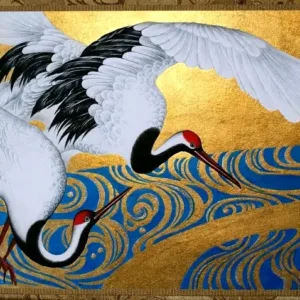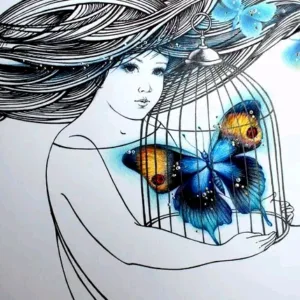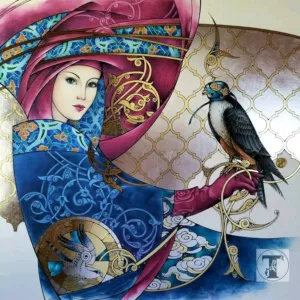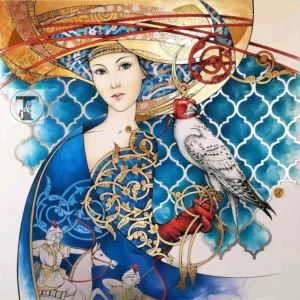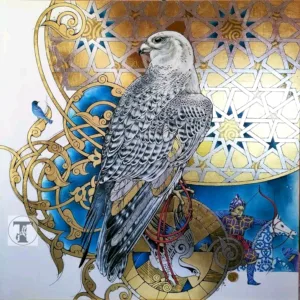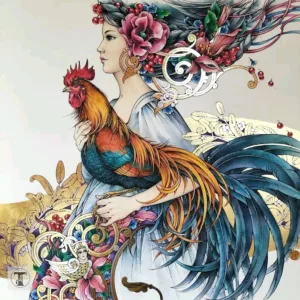Home » Interviews » Ukrainian Tetiana Kruchynina to Arabisk London: My Message is Beauty and to Arouse My Audience’s Imagination, but Art Cannot Stop Conflict!
Interviews
Ukrainian Tetiana Kruchynina to Arabisk London: My Message is Beauty and to Arouse My Audience’s Imagination, but Art Cannot Stop Conflict!
Published
3 months agoon
By
Huda
A bright Ukrainian artist, born in 1976, has been a prominent figure in the art world. Tetiana Kruchynina received her degree in ceramic art from the Kyiv College of Decorative Applied Arts and Design in 1996.
Her artistic talent stems from her early life, resulting in charming designs with bright colours and a blend of techniques. These designs combine modernity and authenticity, transcending local and traditional boundaries and integrating diverse cultures and arts.
Tetiana Kruchynina primarily demonstrates her ability to sketch and design with influences from East Asian and Middle Eastern civilisations and arts. She uses her abilities to capture the alluring essence of the East in the right human and non-human aspects.
Interviewed by: Mohsen Hassan
Her space’s colour and design hint at advanced and modern art while combining the aroma of the past with the contemporary aesthetic.
Tetiana’s artistic masterpieces display beauty, harmony, and precision in design, incorporating elements from various cultures and backgrounds. The vibrant and creative pieces summon flowers from every garden, melodies from every song, and ingredients from every piece, highlighting the depth of her talent and flowing energy, taking us to new realms.
Consequently, the artwork appears to express the unity of the human race, the closeness of human existence, and the unity of the common destiny between the rational and irrational creatures of the planet in a creative, appealing, and elegant blend, as evidenced by nine individual and personal exhibitions of this one-of-a-kind designer as well as her other collective participations.
Despite its modernity, new methods, and intricate compositions, this mix always lowers the wing to its incubation surroundings, and to its actual and fantasy worlds at once.
Tetiana Kruchynina, a UAE-based artist, has created unique and influential designs since 2022. Her work features oriental vocabulary, novelty, and humour, with jewellery pieces and vibrant colour combinations on ceramics, carpets, and metal tools, making her a prominent figure in the UAE’s artistic scene.
Beyond that, Tetiana’s designs are renowned for using artistic cubism, adding a subtle geometric dimension, and drawing inspiration from architectural standards and ancient decorative arts historical data.
The artist’s artwork exudes beauty, joy, and optimism through her love for natural vocabulary, gentle creatures like sparrows, roosters, and birds, and the woman’s interaction with these elements, thereby creating the intended meanings of the painting and its subject.
This was the conversation when Arabisk London reached out to Tetiana Kruchynina, the artist.
First, how do you come up with ideas for your recent artwork? What are the most essential themes in this context?
The traditional local arts of many civilisations and cultures have always piqued my interest throughout my artistic journey in design, but I have focused most on the arts and cultures of the Near and Far East because, to me, the East is the primary source of artistic inspiration.
Therefore, you will find those unique oriental words and elements, like jewellery collections and colour patterns, that are common in this part of the world in all of my designs and artistic formations. These words overlap to form a variety of topics with unique and universal oriental and human connotations that are appreciated by the majority of people who see and watch them.
Does Tetiana Kruchynina use or dread the classic style as an artist trying to grow and modernise your artistic abilities?
I have always held the view that communication between generations is crucial and that fresh and updated works must evoke ancient and traditional creative standards. Because of this belief, I don’t fear classic artistic styles; rather, I use them, build upon them, and subsequently create a new decorative, formative, and creative style.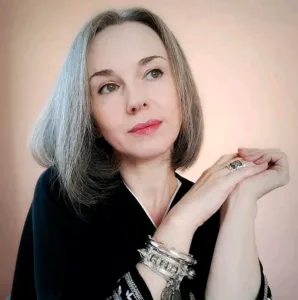
Generally speaking, I depend less on imitating and more on using my creative imagination to capture the formal architectural aspects and standards found in traditional decorative arts, which I then use to create my paintings.
For instance, I’m interested in building upon the expertise of traditional ornamental artists and using it to inform all of my designs and creations. This helps me feel linked to and continuously engage with the experiences of previous generations who came before me in this creative form, and it allows me to always feel like I’m a part of the creators.
Given that an artist is a product of his surroundings, how did your Ukrainian origin affect you? How much did it affect the topics and styles of your artwork?
I obtained my artistic education at the Kyiv College of Decorative Applied Arts and Design. I was able to engage with everything associated with my artistic and heritage environment both inside and outside of Ukraine thanks to the artistic activities, theoretical studies, and applied and practical artistic practices I received there.
Additionally, all of my creative creations are linked to ornamental drawing, and only focus on it since I was associated with this kind of decorative art at the educational and practical levels. This concentration greatly aided me in establishing my path and developing my artistic style in this sector.
Considering the present difficult social and political environment, what are the biggest obstacles Tetiana Kruchynina has encountered as a visual artist and designer in Ukraine?
In my experience, there were no difficulties or obstacles in Ukraine; I was able to pursue a successful career as a visual artist and designer free from social pressures and environmental influences.
In addition, I had complete control over the topics of my paintings and creative drawings within my nation, and before the start of the most recent conflict, which is still going on, my sculptures and paintings were consistently in high demand.
Regretfully, this conflict destroyed all of my artistic accomplishments as well as those of other artists in my profession. I was compelled to flee the damage and the battle to find refuge and start again after the stable, solid, and quiet existence we had there was shattered.
Which phases of artistic and creative labour do you think are most crucial? And how do you often find the idea for new artwork?
Essentially, I usually create a series or set of paintings gradually and without hurrying, which implies that I prioritise quality above quantity to communicate myself more deeply and intriguingly. 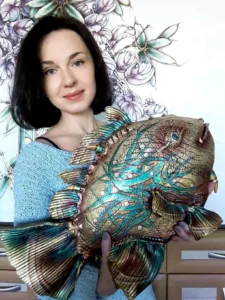
As a result, the pace at which I finish my work never defines it but rather by its depth and immersion in details. Any new project begins with the ideation stage, followed by the composition, colour system, pattern, ornament, and accessory stages, which are followed by wrapping them on the drawing, beginning the search for movement, and finally creating the sketch for any subsequent paintings. Typically, this process takes several days.
With markers, watercolours, and coloured pencils, I begin working on the painting after transferring the sketch onto a wooden board I ordered from the carpenter. I apply varnish and gold and silver sheets once the coloured picture is complete.
Recently, my pieces have grown to a metre by a metre in size. One painting normally needs one to one and a half months to complete, which is not a lengthy period given the majority of the paintings’ pictures and intricacies.
Which art school had an impact on you when you were first starting out in this field?
In my quest for an identifiable artistic style, I became very interested in traditional Japanese art, particularly the paintings from the sixteenth and eighteenth centuries, which are pieces of art that require a great deal of thought, observation, and comprehension of the most crucial details, beginning with the compositions, colours, and decorations.
Truly, I gained a great deal of artistic knowledge from them that aided me in all of my subsequent paintings and sketches.
How do you think the arts function during times of crisis and conflict, given that the war in Ukraine is still going on?
Although art cannot stop or prevent wars or crises, it can emotionally impact viewers, involve them in the specifics of any event, and address them in a way that others cannot. Moreover, it can influence public opinion and change public perceptions of particular events.
In my opinion, an artist in times of crisis and upheaval should be courageous and truthful, first and foremost to himself, and then conscious of his duty for the words he conveys to society via his art.
Concerning the artist’s role: What does Tetiana Kruchynina want the audience to take away from her artwork?
I have a pretty straightforward message: beauty. I use this art form to allow my viewers to go to different realms through my paintings.
My goal is to captivate my audience, arouse their imagination, and encourage them to conjure up their tales of stunning ladies with falcons, aromatic oriental gardens with flowers, and experience the gentle breezes and melodies of birdsong.
This is an invitation to think. On your room’s wall is an invitation to another amazing planet that is close by.
What changes have you made to your artistic methods in recent years? And what are your expectations for the next developments?
Well, I realise how much my artistic techniques and my skills in processing, shaping, and drawing have evolved when I compare my early, timid, and modest works—whose colour spaces didn’t exceed the size of small ceramic plates in their entirety—to my more professional, masterful, and larger works today.
However, I constantly evaluate myself and see that I could have done a better job, and I quickly grow tired of stereotypes and repetition on a personal, psychological, and emotional level. For these reasons, I am constantly keen on developing and acquiring fresh skills and techniques, and only God knows where my curiosity about this art will take me.
Regarding your current artistic endeavours, what are the most significant ones?
Actually, I am quite happy with two artistic endeavours: I illustrated the book Arabesques and Dreams, and Alexandra Filonenko, a Ukrainian author, wrote it before the war.
This book allowed me to fully showcase my drawing abilities, even though I had previously conducted similar experiments. This was especially true after we held an illustration exhibition and displayed the book alongside this piece, which generated extraordinary and unheard-of public and media attention.
This is on top of my other private Emirati project, The Eastern Wind, which has long focused on falconry. This helped me come up with the idea for a series of artworks about falconry, which I had repeatedly put off until I realised that the time had come to realise it.
Consequently, hundreds of people expressed their admiration and surprise at these paintings, stating that they had never seen anything like them before, which made the experience very enjoyable for me.
Lastly, what guidance would Tetiana Kruchynina give aspiring artists hoping to gain expertise in this field?
I would advise them to never stop learning and to draw inspiration from the greatest artistic traditions of the past and present. They should also be careful to tackle new subjects bravely and without fear, and they should devote themselves to discovering their artistic style and expression that fits their individual personalities, interests, and creative energies.
Every artist needs to look for his unique techniques, artistic language, and sense. In addition to the aforementioned, artists must follow their passions and convictions in their creations, drawings, and designs. Eventually, people will recognise and appreciate the unique artistic energy and beauty in these convictions. This is the law of art that always functions, engages, and achieves success.
Read more: Maram Taibah to Arabisk London: I Gained Self-Confidence and Learned to Live in the Present!
You may like
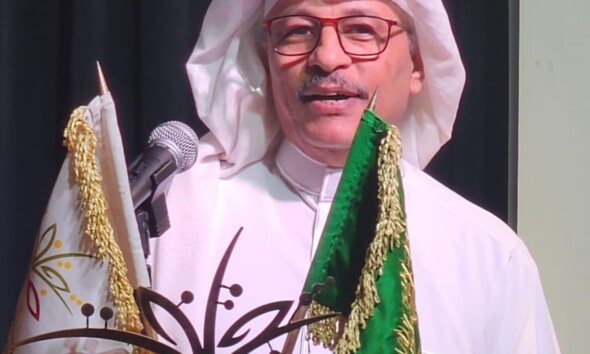
Dr. Hassan Al-Nemi: Politicians’ Choices Have Power, and so Do the Words of Intellectuals!
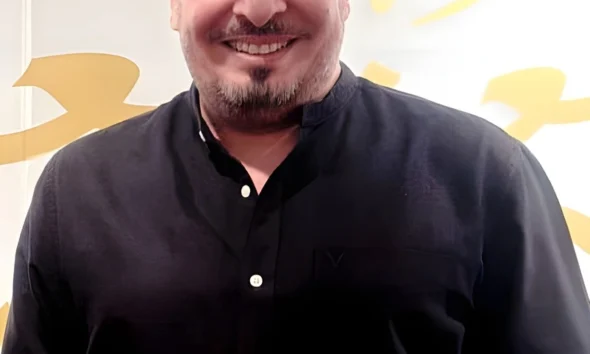
Wael Habbal: The Soul’s Voice is its Mirror, and Only the Proper Means can Bring out its Purity and Magnificence!

Non-Oil Sectors KSA will Depend on to Diversify from Oil by 2025
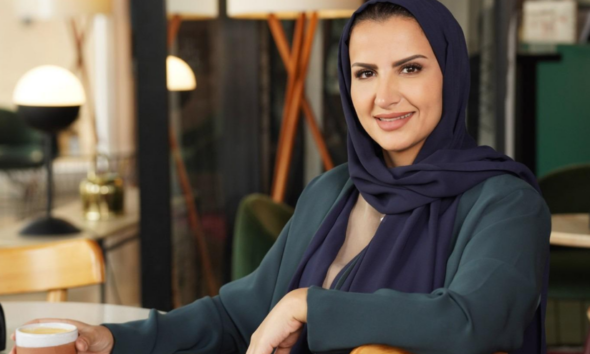
Reem Garash: A Pioneer in Saudi Hospitality
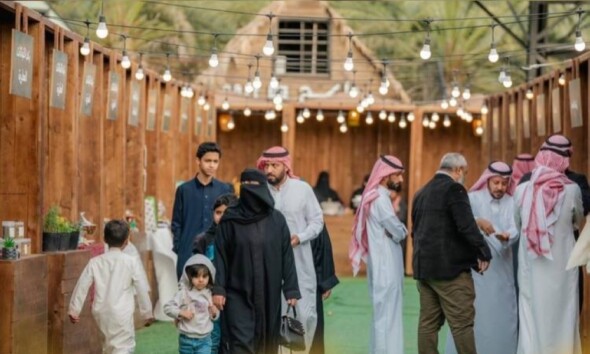
Our Winter is Rural: The Saudi Countryside Becomes a Yearly Success Story


